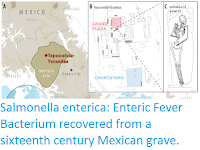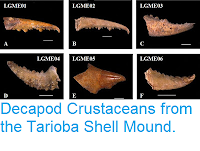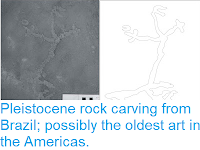The Clovis Culture is known from a distinctive range of artifacts, most notably the style of bifaced spear-head known as a 'Clovis Point', found at locations across North America. These artifacts date from between about 13 200 and about 12 900 years ago, and were for a long time presumed to represent the oldest Human culture in the Americas, thought to have spread across the Bering Straight from northeastern Asia into the Americas, and thought to be ancestral to all subsequent cultures in the Americas, until the arrival of Europeans in the last century. However a string of recent finds have uncovered pre-Clovis artifacts at sites across both North and South America, undermining the status of Clovis as the first American culture, though it is still considered an important step in the history of the continents.
In a paper published in the journal Science Advances on 11 July 2018, Thomas Williams and Michael Collins of the Prehistory Research Project at Texas State University, Kathleen Rodrigues of the Division of Earth and Ecosystem Sciences at the Desert Research Institute, and the Department of Geological Sciences and Engineering at the University of Nevada, Reno, William Jack Rink of the School of Geography and Earth Sciences at McMaster University, Nancy Velchoff, also of the Prehistory Research Project at Texas State University, Amanda Keen-Zebert, also of the Division of Earth and Ecosystem Sciences at the Desert Research Institute, Anastasia Gilmer of SWCA Environmental Consultants Inc., Charles Frederick of Dublin, Sergio Ayala, again of the Prehistory Research Project at Texas State University, and Elton Prewitt of the Texas Archaeological Research Laboratory at The University of Texas at Austin, describe a series of pre-Clovis artifacts from the Gault Site in central Texas.
The Gault Site has been excavated since 2002, and has produced Clovis and later artifacts from a series of layered fluvial (river) deposits. from a river floodplain in the Buttermilk Creek Valley. Collins et al. describe a series of new artifacts from a horizon 65-80 cm below the layer that produced they Clovis material, which has been dated to a minimum of 16 000 years ago.
Stratigraphic profile of the Area 15 excavation block showing the diagnostic cultural materials and components alongside the stratigraphic sequence. Diagnostic projectile points listed on the left were all found within the associated deposits (SMH, St. Mary’s Hall). Stratigraphic unit numbers are shown on the right, and the cultural horizons are highlighted in gray. Collins et al. (2018).
Tha Gault Assemblage artifacts include sophisticated bifaced projectile points with long bevelled blades and sometimes stems with concave margins. These points resemble those assigned to the pre-Clovis Western Stemmed Tradition, but are much older, as the Western Stemmed technology has been dated to between 13 500 and 13 000 years ago. They are also in some ways similar to Clovis Points, though they lack some features seen in Clovis material, such as overshot flaking to produce thinned bifaces, and the flaking on the Gault material is not as fine as that typically seen in Clovis tips.
Gault Assemblage artifacts (A) to (D), (F), and (L) Bifaces. (E) Blade core. (G) Quartz projectile point. (H) and (I) Projectile points. (K) Projectile point tip. (M), (V), and (W) Blade. (N) Unifacial tool. (O) and (T) Gravers. (P) Discoidal biface. (Q) End scraper. (R) to (U) Modified flake tools. (X) and (Y) Lanceolate projectile points. Collins et al. (2018).
See also...
Follow Sciency Thoughts on Facebook.








